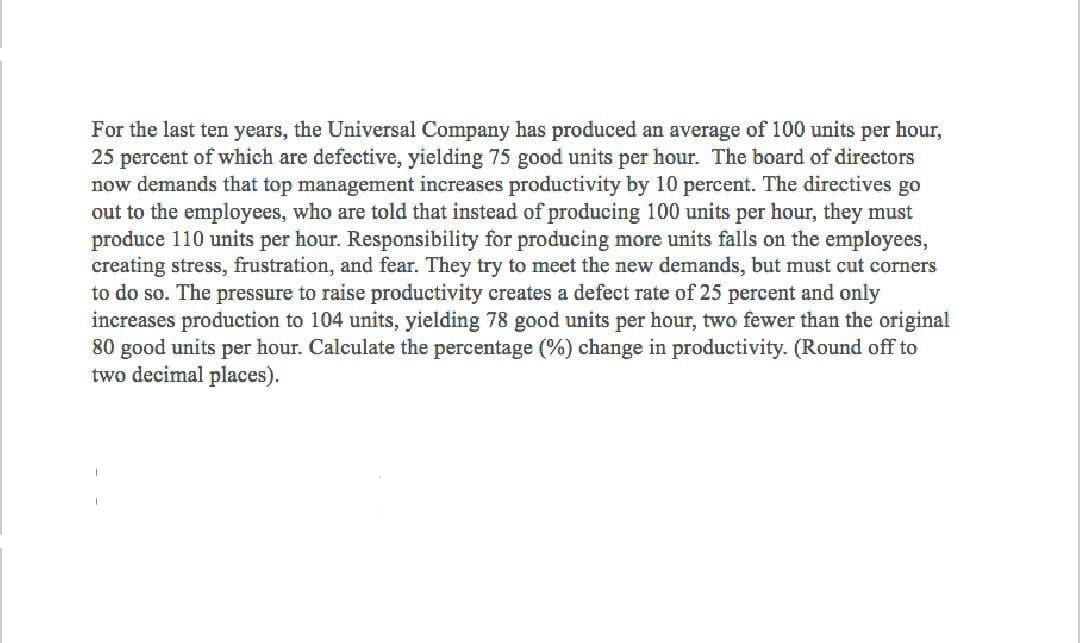For the last ten years, the Universal Company has produced an average of 100 units per hour, 25 percent of which are defective, yielding 75 good units per hour. The board of directors now demands that top management increases productivity by 10 percent. The directives go out to the employees, who are told that instead of producing 100 units per hour, they must produce 110 units per hour. Responsibility for producing more units falls on the employees, creating stress, frustration, and fear. They try to meet the new demands, but must cut corners to do so. The pressure to raise productivity creates a defect rate of 25 percent and only increases production to 104 units, yielding 78 good units per hour, two fewer than the original 80 good units per hour. Calculate the percentage (%) change in productivity. (Round off to two decimal places).
For the last ten years, the Universal Company has produced an average of 100 units per hour, 25 percent of which are defective, yielding 75 good units per hour. The board of directors now demands that top management increases productivity by 10 percent. The directives go out to the employees, who are told that instead of producing 100 units per hour, they must produce 110 units per hour. Responsibility for producing more units falls on the employees, creating stress, frustration, and fear. They try to meet the new demands, but must cut corners to do so. The pressure to raise productivity creates a defect rate of 25 percent and only increases production to 104 units, yielding 78 good units per hour, two fewer than the original 80 good units per hour. Calculate the percentage (%) change in productivity. (Round off to two decimal places).
Microeconomics: Private and Public Choice (MindTap Course List)
16th Edition
ISBN:9781305506893
Author:James D. Gwartney, Richard L. Stroup, Russell S. Sobel, David A. Macpherson
Publisher:James D. Gwartney, Richard L. Stroup, Russell S. Sobel, David A. Macpherson
Chapter8: Costs And The Supply Of Goods
Section: Chapter Questions
Problem 15CQ
Related questions
Question

Transcribed Image Text:For the last ten years, the Universal Company has produced an average of 100 units per hour,
25 percent of which are defective, yielding 75 good units per hour. The board of directors
now demands that top management increases productivity by 10 percent. The directives go
out to the employees, who are told that instead of producing 100 units per hour, they must
produce 110 units per hour. Responsibility for producing more units falls on the employees,
creating stress, frustration, and fear. They try to meet the new demands, but must cut corners
to do so. The pressure to raise productivity creates a defect rate of 25 percent and only
increases production to 104 units, yielding 78 good units per hour, two fewer than the original
80 good units per hour. Calculate the percentage (%) change in productivity. (Round off to
two decimal places).
Expert Solution
This question has been solved!
Explore an expertly crafted, step-by-step solution for a thorough understanding of key concepts.
Step by step
Solved in 2 steps with 1 images

Knowledge Booster
Learn more about
Need a deep-dive on the concept behind this application? Look no further. Learn more about this topic, economics and related others by exploring similar questions and additional content below.Recommended textbooks for you

Microeconomics: Private and Public Choice (MindTa…
Economics
ISBN:
9781305506893
Author:
James D. Gwartney, Richard L. Stroup, Russell S. Sobel, David A. Macpherson
Publisher:
Cengage Learning

Economics: Private and Public Choice (MindTap Cou…
Economics
ISBN:
9781305506725
Author:
James D. Gwartney, Richard L. Stroup, Russell S. Sobel, David A. Macpherson
Publisher:
Cengage Learning


Microeconomics: Private and Public Choice (MindTa…
Economics
ISBN:
9781305506893
Author:
James D. Gwartney, Richard L. Stroup, Russell S. Sobel, David A. Macpherson
Publisher:
Cengage Learning

Economics: Private and Public Choice (MindTap Cou…
Economics
ISBN:
9781305506725
Author:
James D. Gwartney, Richard L. Stroup, Russell S. Sobel, David A. Macpherson
Publisher:
Cengage Learning


Economics (MindTap Course List)
Economics
ISBN:
9781337617383
Author:
Roger A. Arnold
Publisher:
Cengage Learning